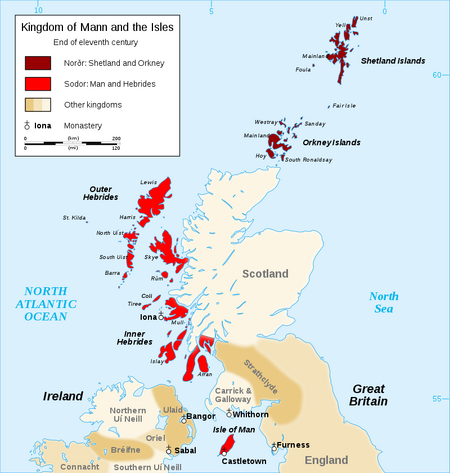Papa Westray

Papa Westray, also known as Papay, is one of the Orkney Islands in Scotland, United Kingdom. Dating from 3500 BC to 3100 BC, it is similar in design to Skara Brae, but from an earlier period, and it is thought to be the oldest preserved standing building in northern Europe.
Location
History
The Knap of Howar Neolithic farmstead (Historic Scotland) is the oldest preserved house in northern Europe, dating from around 3500 BC.[1]/3600 BC[2] The homestead, which consists of two roughly rectangular stone rooms side by side, linked by an internal door, and with doors to the outside at the west end, is partly subterranean, and virtually complete to roof height. Examples of the round-bottomed Unstan ware have been found here, and provided the key to dating the settlement.[3]
According to tradition, in the 8th century AD, the Pictish King Nechtan attempted to seduce a young woman from the island named Triduana, who in response gouged her own eyes out. She later became abbess of a nunnery at Restalrig, now part of Edinburgh, and was in due course canonised as St Tredwell. A chapel was consecrated to her on Papa Westray and became a place of pilgrimage for people with eye complaints.[4]
The island is one of the 'Papeys' or 'islands of the papar'. Joseph Anderson noted that:
- "The two Papeys, the great and the little (anciently Papey Meiri and Papey Minni), [are] now Papa Westray and Papa Stronsay... Fordun in his enumeration of the islands, has a 'Papeay tertia' [third Papey], which is not now known. There are three islands in Shetland (Zetland) called Papey, and both in Orkney and in Shetland (Zetland), there are several districts named Paplay or Papplay, doubtless the same as Papyli of Iceland."[5]
Also on the island is the 12th-century parish church of St Boniface[6] with a carved Norse "hogback" gravestone (probably also 12th century) in the churchyard. This stands on a substantial and largely unexcavated 9th century, or earlier, Pictish religious site – possibly including a bishop's residence. Remains of a heavily eroded broch can be seen on the shore. Early Christian carved stones, which may date from as early as the 7th century AD, found at this site are on display in Orkney Museum in the Tankerness House, Kirkwall and the National Museum of Scotland, Edinburgh. These may be the earliest evidence for Christianity to survive in the Northern Isles.
Another ancient monument that can be visited is a well-preserved Neolithic chambered cairn on the small island of Holm of Papa Westray, a little east of Papay itself (and readily visible from the larger island). The long, stalled cairn, built of local stone, was once a communal burial place for the bones of an ancient community. It is protected by a modern roof and entered by a man-hole from above. This can be seen at any time of day, but visitors must arrange privately for a boat through the local co-op.
Papa Westray is the birthplace of the Orcadian educator and man of letters, John D. Mackay.
Related sites in Orkney
A comparable, though smaller, site exists at Rinyo on Rousay. Unusually, no Maeshowe-type tombs have been found on Rousay and although there are a large number of Orkney–Cromarty chambered cairns, these were built by Unstan ware people.
Knap of Howar, on the Orkney island of Papa Westray, is a well-preserved Neolithic farmstead. Dating from 3500 BC to 3100 BC, it is similar in design to Skara Brae, but from an earlier period, and it is thought to be the oldest preserved standing building in northern Europe.[7]
There is also a site currently under excavation at Links of Noltland on Westray that appears to have similarities to Skara Brae.[8]
External links
References
- ↑ Keay, J. & Keay, J. (1994) Collins Encyclopaedia of Scotland. London. HarperCollins.
- ↑ Alistair Moffat: The British: A Genetic Journey, Birlinn, 2013,ISBN:9781780270753, p.78
- ↑ Keay, J. & Keay, J. (1994) Collins Encyclopaedia of Scotland. London. HarperCollins.
- ↑ "St Treadwell's Loch, Papay". Orkneyjar.
- ↑ Anderson, Joseph (ed.) (1873) The Orkneyinga Saga. Translated by Jón A. Hjaltalin & Gilbert Goudie. Edinburgh. Edmonston and Douglas. The Internet Archive.
- ↑ "St Boniface's". Scottish Church Heritage Research.
- ↑ "The Knap o' Howar, Papay". Orkneyjar.
- ↑ Darvill, Timothy (1987). Prehistoric Britain. London: Yale University Press. ISBN 0-300-03951-4.p. 105

